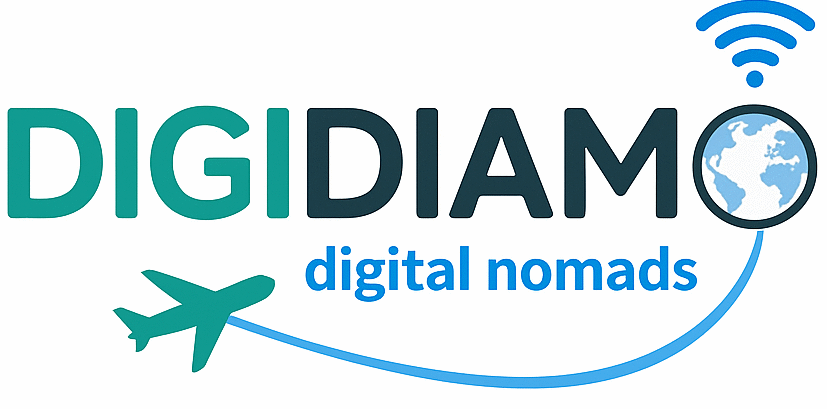Remote work for digital nomads: the complete 2025 guide
Introduction
Remote work has become the foundation of the digital nomad lifestyle. What used to be a rare perk for a small group of freelancers is now a standard option across industries. Companies care less about office presence and more about results. This shift allows people to design careers around freedom rather than geography. Yet thriving as a nomad requires more than a laptop and Wi-Fi. You need the right opportunities, the right tools, and the right habits to make income and travel coexist without constant stress.
This guide brings together the essentials: job opportunities, practical tools, productive routines, common challenges, and the destinations that support this lifestyle best. Each part connects to more detailed resources, giving you a map to build a sustainable career on the move.

Remote job opportunities for digital nomads
The first step is choosing work that travels well. Not all jobs are suited to constant movement. Some require stable office setups or local licenses. Others fit perfectly with a mobile lifestyle. Good nomad jobs are measured by output, not hours on a clock. They rely on cloud tools, pay enough to cover living costs, and remain flexible across time zones.
There are several models to consider. Salaried remote jobs offer stability, while freelancing gives freedom and variety. Contractor agreements pay well but shift responsibility for taxes and insurance onto you. Part-time retainers give a steady base while leaving room for projects. Even micro tasks and surveys, though not sustainable long term, can serve as training grounds for learning platform etiquette.
High-demand areas in 2025 include software development, design, marketing, content creation, education, and customer support. Beginners can also start with simpler roles such as transcription, data entry, or virtual assistance. These early paths may not pay much but open doors to better contracts later.
Reliable platforms make finding work easier. We Work Remotely, Remote OK, and FlexJobs curate full-time opportunities. Upwork and Freelancer provide high volume freelance projects, though competition is steep. Contra and TopTal target premium contracts for skilled workers. Direct outreach to startups often bypasses crowded job boards and builds stronger connections.
Remote job opportunities are wider than ever. Choosing one model and committing to it for a few months is better than switching constantly. With steady focus you build both skills and reputation. For a detailed breakdown of the strongest options this year, read about remote job opportunities for digital nomads in 2025.
Top remote jobs you can start with no experience
A common question for aspiring nomads is how to begin without years of background. The good news is that remote work now rewards reliability and curiosity as much as experience. Many companies prefer to hire people who can learn quickly rather than chase long résumés. That shift has opened the door to a range of entry-level roles.
Customer support is one of the easiest starting points. Clear writing and patience are valued more than technical skills. Virtual assistant work is another option. Entrepreneurs and small businesses outsource inbox management, scheduling, and travel bookings to lighten their load. Over time, assistants often expand into managing social posts or basic bookkeeping.
Transcription roles turn audio into text, ideal for people with sharp typing and good grammar. Online chat support is another entry-level path, popular with people who prefer typing to calls. Data entry, while repetitive, provides steady income if you focus on accuracy. Voice work is growing too. With a simple USB mic and free software you can record narrations for audiobooks or ads.
Surveys and micro tasks are not long-term careers but can fund small gear upgrades while you search for more stable jobs. The point is not to jump endlessly between options but to pick one lane for at least three months. That focus builds skills, ratings, and momentum.
Platforms like Rev, Belay, SupportDriven, and Clickworker offer steady beginner tasks. A concise skills sheet or short video introduction often works better than polished résumés. Employers want to know if you can communicate clearly and show up reliably.
Starting with no experience is less about luck and more about consistency. Each small win adds weight to your profile. Within a year, many beginners progress into specialized roles or stable contracts. For a deeper look at these accessible options, explore the guide to top remote jobs you can start with no experience in 2025.
Best remote jobs for digital nomads to land in 2025
Once you move past the entry level, the question becomes which jobs balance income with freedom. The best remote jobs for nomads in 2025 share a few qualities: they can be done entirely online, pay enough to cover global living costs, and adapt smoothly to changing time zones. These roles are not just stopgaps, they are long-term careers that travel well.
Software and product development continues to lead. Companies around the world need developers, engineers, and product managers, and they are willing to hire across borders. Portfolios of real projects carry more weight than degrees. Pay often starts above 70,000 USD annually and scales quickly with experience.
Content strategy and copywriting are also in demand. Brands publish nonstop, and they need writers who understand both storytelling and search intent. Specialists with strong niches or subject expertise can charge 30–80 USD per hour. Building a personal site with samples is often enough to win work.
Digital marketing and paid ads are valuable for their measurable results. Growth marketers, media buyers, and email specialists can work from anywhere as long as they deliver clear performance metrics. Monthly retainers average around 3,000 USD for mid-level talent.
UX and graphic design roles thrive on remote teams. Tools like Figma, After Effects, and Canva make collaboration easy. Motion design and prototyping skills give freelancers an edge. Strong visuals in your portfolio are more important than credentials.
Customer success and support keep users loyal to subscription products. While entry pay is lower than tech build roles, growth into management is steady. E-learning and coaching also remain strong. Tutors, mentors, and coaches earn between 15 and 100 USD per hour depending on specialization. Recording evergreen courses creates passive potential.
Emerging niches are worth noting. Web3 community management, AI prompt engineering, and sustainable travel consulting are all growing. Remote operators for small SaaS products also see rising demand. These fields reward early movers willing to learn quickly.
For nomads, the best jobs are not just about high pay. They are about alignment with your lifestyle, natural rhythm, and long-term plans. To compare options in detail and explore which roles travel best, see the guide to the best remote jobs for digital nomads to land in 2025.
Top freelance jobs for digital nomads in 2025
Freelancing has long been the fastest way for nomads to turn skills into income. Unlike salaried roles, freelancing offers freedom to choose clients, set rates, and scale workload up or down depending on your travel rhythm. The trade-off is responsibility. You manage outreach, contracts, and payments on your own. For many, the independence is worth it.
Design is one of the strongest freelance fields. Brand identity designers craft logos, color palettes, and style guides for startups and e-commerce founders. Rates begin near 600 USD for small packs and climb above 2,000 USD for full brand systems. Showing mockups in real contexts phone screens, packaging, billboards helps close deals.
Copywriting is another steady path. Conversion copywriters create landing pages, email sequences, and ad campaigns. Pay starts at 250 USD per email and can exceed 1,500 USD for sales pages. What matters most is connecting with the audience in their own words.
No-code web builders use tools like Webflow and Bubble to launch sites quickly. Agencies and consultants often outsource builds. Projects start around 900 USD and can reach 4,000 USD for complex builds. Speed is key live wireframing sessions calm clients and secure contracts.
Video editing for social platforms is booming. Creators and brands need short clips formatted for TikTok, Reels, and YouTube Shorts. Editors who add captions, graphics, and trending audio earn steady retainers. Starting rates hover around 60 USD per clip or 1,200 USD monthly for packages.
Other high-demand freelance roles include paid ads strategists, podcast show-note writers, community managers, online course designers, AI prompt engineers, data dashboard builders, voice-over artists, and technical SEO fixers. Each field rewards a mix of technical skill and communication clarity.
Choosing the right lane depends on your strengths and interests. Mapping out what tasks put you in flow, then testing small paid projects, is the safest entry. Over time, freelancing opens doors to agencies, partnerships, and even product creation. To explore these paths with pricing signals and role details, read the guide to top freelance jobs for digital nomads in 2025.
Remote jobs for digital nomads: secure a salary in 2025
Freelancing offers flexibility, but many nomads prefer the stability of a fixed paycheck. Salaried remote roles bring predictable income, health benefits in some cases, and fewer worries about finding the next client. They also make it easier to plan long-term travel without constant stress about money.
Companies structure these roles in different ways. Fully distributed firms like Buffer or GitLab never had offices to begin with. They run entirely online, often providing home office stipends and wellness budgets. Remote-first hybrids such as Shopify keep a headquarters but let employees work from anywhere, usually requiring a few hours of overlap daily. Larger brands often build satellite teams, aligning hours with customer markets. Contractor agreements are also common, where workers send invoices through platforms like Deel or Remote. Pay is higher, but you handle your own taxes and insurance. Finally, part-time retainers offer around 20 hours a week, giving steady income while leaving space for side projects.
Finding stable listings requires careful search. We Work Remotely, Remote OK, and FlexJobs specialize in remote-friendly jobs. Oyster Talent Marketplace connects applicants with firms already using compliant payroll systems. LinkedIn alerts are also powerful, especially when combined with referrals.
Resumes for remote jobs must highlight outcomes, not tasks. Recruiters want to see measurable results and familiarity with async tools like Notion or Slack. Interviews often test professionalism in a remote context: webcam quality, communication style, and how you manage time zones. Negotiating pay requires awareness of whether the company uses location-based salaries or global bands. Anchoring requests around performance and impact is more effective than citing personal expenses.
Salaried roles also bring paperwork. Some countries offer digital nomad visas, while employer-of-record services manage compliance in others. Contractors must set aside funds for taxes and insurance. Understanding double taxation treaties avoids costly surprises.
Building sustainable routines is crucial. Anchor hours, reliable workspaces, exercise, and community activities prevent burnout. Transitioning from freelance to salary is common. Testimonials from past projects and proof of consistent delivery often tip the balance. Long-term growth comes from upskilling quarterly, joining mentorship circles, and publishing case studies.
Stable income supports the freedom to choose where to live. For a closer look at how to find and keep these roles, explore the guide to remote jobs for digital nomads that secure a salary in 2025.
Essential remote work tools for digital nomads
Even the most talented nomad cannot thrive without the right tools. Offices provide infrastructure like IT support, secure networks, and meeting rooms. On the road, you replace all of that with apps and devices you can carry. A reliable toolbox is what turns remote chaos into smooth workflows.
Communication sits at the core. Slack organizes conversations by channel and integrates with project apps. Zoom and Google Meet cover video calls, while Loom allows quick recorded updates that reduce meeting fatigue. Clear, asynchronous communication saves hours across time zones.
Project and task management comes next. Trello is simple and visual, perfect for freelancers juggling clients. Asana scales well for teams with complex projects. Notion blends tasks, documents, and databases in one space, making it a popular choice among nomads. ClickUp offers an all-in-one platform for those who prefer centralization.
File storage must be cloud-based. Google Drive, Dropbox, and OneDrive all sync files across devices, while offline backups on portable SSDs prevent data loss. For collaboration, Google Docs and Sheets are still the fastest tools.
Finance is a common friction point for nomads. Wise provides low-fee international transfers and multi-currency accounts. Payoneer is widely accepted on freelance platforms. PayPal remains universal, though fees run higher. Revolut helps with budgeting and daily payments in multiple currencies. Simple invoicing apps like Wave or FreshBooks keep finances tidy.
Security cannot be ignored. VPNs like NordVPN encrypt data on public Wi-Fi. Password managers such as Bitwarden protect logins across multiple accounts. Antivirus programs like Malwarebytes add an extra layer of safety. Losing data or accounts while abroad is far costlier than investing in security.
Productivity tools anchor focus. Todoist helps manage tasks, while RescueTime and Clockify track how you spend hours. Forest gamifies focus with timers, useful in noisy cafés. Pair these with noise-cancelling headphones and you recreate office-like concentration anywhere.
Finally, backup internet solutions save reputations. Portable hotspots like Solis, local SIM cards, and offline Google Docs ensure work continues even if Wi-Fi fails. Dropping a client call once is unlucky, but twice looks unprofessional.
Every nomad builds a personal stack, but covering communication, management, finance, and security is non-negotiable. To explore these categories in depth and compare the best picks, see the guide on essential remote work tools for digital nomads in 2025.
Building a productive remote work routine
Freedom without structure often turns messy. Remote workers who succeed build routines that keep them steady across changing time zones and cultures. A routine does not mean rigid office hours. It means setting anchors that travel with you, so your mind and body know when to focus and when to rest.
Anchor hours are a powerful tactic. Choose three to four hours daily for deep work and stick to them regardless of country. This consistency makes deadlines predictable for both you and your clients. Pair anchor hours with rituals like morning stretches, journaling, or making coffee. These cues replace the commute as signals to start work.
Work environments shape productivity too. Test Wi-Fi, noise, and comfort before committing to a café or coworking space. Many nomads rotate between both: coworking for social energy, cafés for creativity, and home for focus.
Managing time zones is another core part of routine. Use tools like World Time Buddy to map overlap with clients. Block these hours for meetings or collaborative tasks. Protect the rest of the day for deep work.
Productivity apps help routines stick. Clockify tracks billable hours. Todoist organizes daily tasks. RescueTime highlights distractions, while Forest uses focus timers. Combine these digital tools with offline habits like handwritten lists or evening walks to mark the end of the workday.
Health should be baked into routine. Pack resistance bands or use bodyweight workouts when gyms are scarce. Carry a refillable bottle to stay hydrated. Protect sleep by using eye masks and earplugs. Energy drives focus more than any app can.
Social balance matters too. Loneliness grows when weeks pass without meaningful connection. Make coworking days or local meetups part of your rhythm. Even a weekly language exchange or shared dinner helps.
Building routines takes practice, but the payoff is huge. Productivity rises, stress drops, and free time feels richer. For practical examples and detailed strategies, read the guide on building a productive remote work routine as a nomad.
Biggest remote work challenges and how to overcome them
Remote work gives freedom but also delivers a set of obstacles that office workers rarely face. For nomads, the combination of travel and work multiplies those hurdles. Internet outages, shifting time zones, and cultural isolation can all erode productivity if left unchecked. The key is to recognize challenges early and design systems that prevent them from derailing your lifestyle.
Internet reliability is the first issue. Unstable connections interrupt calls and delay uploads. The solution is layering. Always carry a local SIM card with enough data, invest in a portable hotspot, and download offline copies of key documents. This way, you remain dependable even when Wi-Fi fails.
Time zone clashes are another recurring challenge. When you work across continents, overlap windows shrink. Without structure, you end up working nights or sacrificing sleep. Tools like World Time Buddy help map overlap. Agreeing on fixed anchor hours and relying more on asynchronous updates keeps collaboration smooth.
Isolation also sneaks up on many nomads. Traveling alone, even in lively cities, can feel empty without community. Joining coworking spaces, attending local meetups, and scheduling regular calls with friends or family keeps human connection strong. Mixing solo stays with coliving experiences also balances solitude with companionship.
Distractions are part of the lifestyle. Beaches, nightlife, and new friends tempt you away from deadlines. The way forward is time-blocking focus first, explore later. Headphones, focus timers, and clear boundaries with travel companions protect work hours.
Burnout is a hidden risk. Many nomads work harder than they did in offices, trying to prove reliability from afar. Protect energy with rest days, digital detox weekends, and realistic weekly schedules. Tracking hours with tools like Toggl ensures you do not overwork.
Security cannot be overlooked. Public Wi-Fi brings risks of data theft. VPNs, password managers, and external backups protect your files and accounts. Simple precautions prevent costly mistakes.
Finally, financial instability affects freelancers most. Some months overflow with projects, others run dry. Stability comes from layering income streams: one anchor client for essentials, side projects for growth, and savings of at least three months’ expenses.
Challenges are not signs that the lifestyle is failing. They are natural parts of remote work. By planning for them, nomads turn obstacles into manageable routines. For a full breakdown of each issue and tested solutions, see the guide on the biggest remote work challenges and how to overcome them.
Best remote work-friendly destinations for 2025
Choosing where to base yourself is as important as choosing the right job. A good destination makes work smooth with reliable internet, affordable housing, and a welcoming community. A poor one turns daily life into a struggle. For nomads in 2025, several cities and regions stand out as strong options.
In Europe, Lisbon continues to attract nomads with its balance of culture, cost, and infrastructure. Coworking spaces are abundant, internet is fast, and Portugal’s digital nomad visa makes long stays easier. Bansko in Bulgaria is smaller but has become famous for affordability and its tight-knit coworking community. For those seeking a business-friendly setup, Tallinn in Estonia remains attractive thanks to its e-residency program.
Asia offers some of the most established hubs. Chiang Mai in Thailand remains a classic choice, with low costs, thriving cafés, and plenty of coworking spaces. Bali mixes lifestyle perks with nomad communities in Canggu and Ubud, though power cuts still happen. Ho Chi Minh City in Vietnam combines affordability with strong Wi-Fi and a buzzing urban culture.
Latin America has grown rapidly as a nomad region. Medellín in Colombia is praised for its climate and community, with rent and coworking spaces still affordable. Mexico City balances culture, food, and a growing startup scene. Buenos Aires offers low living costs for those with strong currencies, making it appealing despite economic instability.
Africa is gaining attention too. Cape Town in South Africa offers natural beauty with modern coworking hubs, though safety requires awareness. Dakhla in Morocco is emerging as a quieter option. Known for kitesurfing and calm environments, it suits nomads who want focus rather than nightlife.
North America has higher costs but unique advantages. Austin in the US has a thriving tech scene, while Montreal in Canada offers cultural depth and strong infrastructure. Both cities are ideal for those who want to stay closer to Western markets.
Picking the right place depends on your needs. If you want low costs, Asia or Eastern Europe remain strong. If community is your priority, hubs like Bali or Lisbon provide it. If you prefer quieter focus, towns like Dakhla or Bansko work better.
Destinations shape routines, costs, and even energy levels. Choosing wisely can turn remote work from a daily battle into a lifestyle that flows naturally. For detailed comparisons of cities and their strengths, explore the guide to the best remote work-friendly destinations for 2025.
Conclusion
Remote work has matured into a sustainable lifestyle for digital nomads. Opportunities exist for every level, from entry roles that require no prior experience to high-paying positions in tech, design, and marketing. Freelancing provides freedom while salaried roles bring stability. The right tools replace office infrastructure, and solid routines keep you productive across time zones. Challenges like poor internet, loneliness, and burnout are real, but with systems in place they can be managed. Destinations matter too. A city with reliable Wi-Fi, affordable living, and a supportive community can make all the difference.
The path is not about chasing every option at once but about layering the right mix for your stage. Build skills, strengthen habits, and choose locations that fit your rhythm. Over time, consistency compounds into freedom and security. If you are ready to begin from scratch, our guide on top remote jobs you can start with no experience in 2025 is the best place to take your first step.






